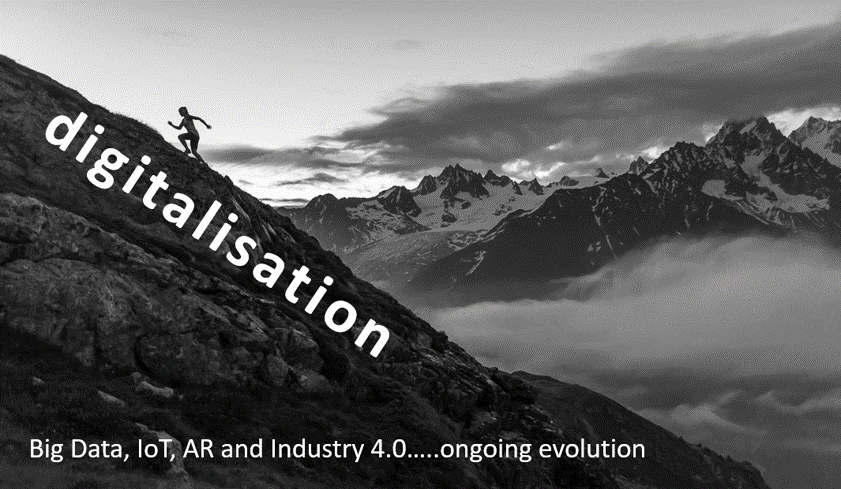The principles of Digital Transformation are a generation old. It’s how we now go about it that is new. New technology also supports far superior outcomes, and the plan is still ever so vital.
- What is digital Transformation?
- What is a Digital Transformation strategy?
- Why is Digital Transformation so important?
- What is a Digital Transformation platform?
- What are the benefits of going digital?
- What is OT and IT Convergence?
- When does Change Management begin for a Digital Transformation implementation?
- Why is Change Management a key to appropriate selection and configuration of new Apps?
- What should we learn about historical Digitisation and systems engineering?

Digital Transformation is the latest new term in the wake of Big Data, IoT, AR and Industry 4.0, but how much of it is actually new? We have been doing digitalisation for a long time now, since the 90’s. So, what is transformation? Is it because we now have a beachhead of technologies? Or is it because it’s time the investment delivered? Or is it because we never understood the value until now?
What is Digital Transformation?
Digital Transformation is a process. It usually relates to a business or an organisation’s operational strategy to optimise the business in some fashion or implement a step change in how the organisation performs. Some will argue it is the reincarnation of Business Process Engineering (BPE) which may now have “come of age” due to the growth of digital technologies including IOT and Big Data Platforms. Digital Transformation is more than a strategy, more than a process and is not limited to a selection of technology. Choosing a technology platform is an important step in this journey to reshape for next generation “in touch” businesses, however the success rate of AI projects and smart solutions (the supposed holy grail) is dismally low as reported by many data scientist thought leaders.
What is a Digital Transformation strategy?
A Digital Transformation strategy is particularly important because it uniquely defines the direction of a considered journey. Because it is not the solution per se, it is even more important to define in some detail how technology, people (culture and change management) and systems (procedures and procurement) will cooperate to make best use of the new direction. A Digital Transformation is perhaps no different than a new strategic plan, however the new technology aims to digitize aspects of the business inputs and outputs to improve decision making, the sharing of analytics and ultimately improve performance. The digital transformation strategy must include ensuring that existing data inputs are Quality Assured so that newcomers (not the old system die-hard’s), can consume the information without intimate knowledge about all of the historical data exceptions. The strategy should decide what data is important to the business, what should be left as a sleeping giant and what data needs to be lifted up
What is a Digital Transformation platform?
A digital transformation platform is usually software. Sometimes a provider may leverage the cloud for infrastructure. It may come configured and appear to be a specific application, it may be an inflexible specific application, or it may be an open platform ready to be customised to meet whatever you can dream up. The appetite for which path to take should leverage the effort made in the strategies of the business ensuring the business doesn’t transform into a technology provider because it has adopted a new technology which drags the business resources into deployment and constant maintenance activities.
Why is Digital Transformation so important?
Culture, information management and financial imperatives are demanding change. Digital Transformation is seen as the pathway to “get some action” on the way to being modern and recognised as an industry leader. No different than any other plans to do better, some will succeed, and many will fail. Failure may be part of the longer-term solution if the concept proving process is qualifying what the business needs, however large-scale failures due to a poor high-level business plan are likely to only be discovered when it is too late. After all, who is going to put their hand up when they are working on the latest cool technology and say; “this doesn’t seem to be working”. It requires real discipline to call the troops off the field calling a time out and then deciding to forfeit the match. For the wellbeing of the players (in this case the organisation) this is sometimes required.

What are the benefits of going digital?
Getting on the digital journey forces consideration and challenges many norms. The norms could be people practice, technologies and ways of doing just everyday activities. At the very least it should lead to better quality data (trusted data) [link to Trusted Data Landing Page] so the business can decide what to do next. This is a fundamental element of digital transformation.
On the flip side, even if the high-level people, culture and financial management systems hang together and play nicely, if the data is poor, it’s a failure. Fancy analytics and big screens only amplify the quality of the data at the end of the day adding what success looks like or what failure looks like. Failure leads to setting back plans, additional cost, losing confidence, or worse still acting on bad information and not being aware of the situation. It is difficult to start again getting it wrong the first time around.
The key with this new technology wave is to navigate into the storm head on before the tsunami of new tech arrives and we are blindsided.
What is OT and IT Convergence?

One thing remains constant amidst the change; OT partners can deliver the foundation technology stack and the customized solution to accelerate and de-risk this digital transformation journey. And journey it is, as this is not a new this is Business Process Reengineering (BPR) spoken of 2 decades ago but now the technology has finally caught up with the ideas.
OT and IT Convergence as a theme has dissipated by the emergence of specific business solutions that demand this integrated approach anyway. In some respects, new applications are being developed which bridge between IT/OT without consideration of the traditional separation of business systems.
Automation Alley Industry 4.0 Report (Finding 5 of 5): “Don’t underestimate the “people factor.” This will be your greatest asset as well as your greatest hindrance to success.
When does Change Management begin for a Digital Transformation implementation?
Change management isn’t a commissioning activity, it starts right from the beginning for any project. There are promoters and detractors in every organisation including the service provider and end user. Begin early with the people factor helps create certainty around how the business is going to change, who is the champion and when activities are due to be completed. Technology projects always have hiccups, so planning for that and planning who is going to manage the hiccups is key to have the right posture which caters for products updating mid-stream or not working just as the glossy brochure said they would.
Why is Change Management a key to appropriate selection and configuration of new Apps?
Change Management is particularly important with Digital Transformation because the organisation footprint is much wider than the traditional OT user group. Requirements management, training people, and helping stakeholders understand impacts on existing methodologies are all important to the whole of business. Some people get excited and want more and more too fast! Even running too fast can empty an organisation of its energy reserves required for the home straight.
Industry 4.0, Big Data and Analytics, IoT and AI are changing business performance. Companies are developing new mindsets in terms of data, knowledge, product lifecycle, business lifecycle and go to market strategies, just to name a few. The use of IIoT’s connectedness as a technology is so enormous that businesses are having a hard time assessing its impact on their decision-making process and still working out new ways to view, consume and sell or value their data.
Technology solutions are increasingly complex and there is a sense of having to read the fine print. Even for those who do this every day, it requires complete commitment to learning technology and staying current.

What should we learn about historical Digitisation and systems engineering?
20 years ago the big drive was to unify disparate systems. Many vendors have during this time offer their agnostic solution, one brand and less issue approach. This very valid solution concept has worked for many large organisations but does not suit everyone. IIoT and the cloud have challenged some of these fundamental proprietary interconnectivity models. Today we are seeing organisation incorporating modern and more open standard interfaces. Keeping in mind that this big end and total enterprise-wide model is not the agile approach many are taking with IIoT. Trials and testing specific standalone applications are common practice now as organisations grapple with how to get started with “digitisation”. Without realising it, if we do not consider these silo projects and how they are to roll into the enterprise fully at some point, we are inadvertently rolling out disparate systems using standalone IoT solutions. In some ways we are leaping forward on the domestic front where we don’t care if we have 20 applications to run our home entertainment needs, but creating some new problems to solve on the commercial front by creating islands of disparate technologies. With the threat of less skilled people available who can truly architect enterprise solutions, we should be more cautious today about repeating what we did 20 years ago and spent a decade undoing.
Most certainly we have the technology to do just about anything in terms of business process reengineering, what we also desperately need is a way to have people a part of this in such a way that the solutions are for the greater good of the entire organisation and are not “uninstalled” as quickly as the App advocates change jobs. Not wanting this to be a negative statement, the real point is Applications have a much shorter lifecycle and that should be planned for. Subscription supports more frequent application churn and less dependency on single vendors, however IT and engineering costs remain unchanged. There is a risk that for business applications this high IT and engineering cost can be repeated more often if the technology is recycled with every great new idea is presented to the marketplace. At the end of the day, it is still about empowering people to enjoy performing their roles. We appear to have reached appoint where technology is cool, not something to be afraid of and now more informed decisions are being made using real time intelligence that can be relied upon with confidence. Digital Transformation occurs for organisations who connect people with technology with the bigger picture in mind.

